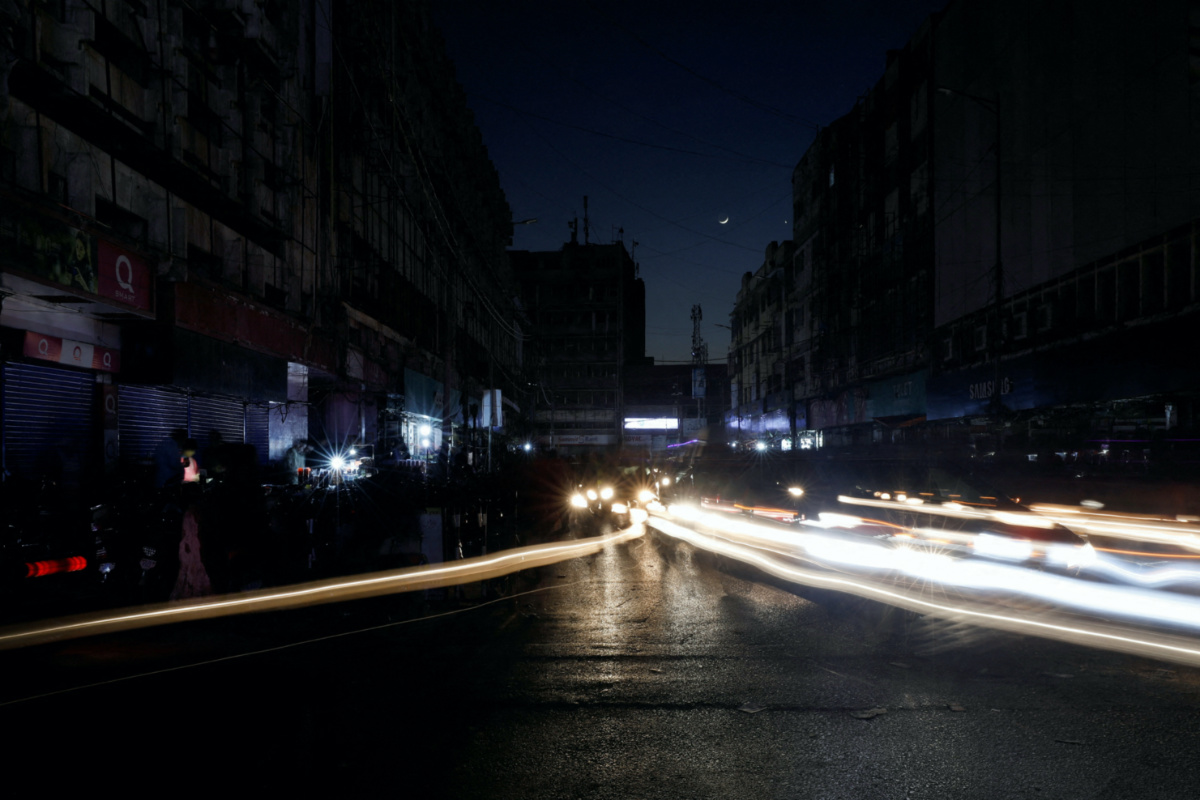Islamabad, Pakistan/Singapore
Reuters
Pakistan’s generators produced more power than was required on Monday, causing voltage fluctuations that culminated in a system collapse that plunged 220 million people into darkness, an internal government document reviewed by Reuters showed.
Complete grid failures are rare, and operators of modern grids count local shocks from integration of renewable energy as their primary challenge. But the blackout in Pakistan on Monday was its second near-complete grid failure and the third in south Asia in three months.

Vehicle lights cause light streaks on the road along a market, during country-wide power breakdown in Karachi, Pakistan, on 23rd January, 2023. PICTURE: Reuters/Akhtar Soomro/File photo.
The grid’s failure plunged 220 million people into darkness for a whole day and disrupted commercial activity as outages also hit internet and mobile services.
The blackout was triggered by the power grid’s frequency rising to 50.75 hertz early on Monday, causing severe voltage fluctuations in transmission lines in the south, according to the internal note. A frequency over 50 hz indicates the power generated exceeds demand, while a frequency under 50 hz points to supply falling short of demand.
Grid operators attempt to keep the frequency of the grid stable at 50 hz, with deviations over 0.05 hz typically considered abnormal. The frequency of the grid was already 50.30 hz moments before the incident, according to the note.
The severe frequency fluctuations in the transmission lines caused it to trip, Sajjad Akthar, general manager at state-run National Transmission and Distribution Company (NTDC) wrote in the note drafted on Tuesday.
“Transmission lines tripped, which resulted in isolation of north and south system,” Akthar said in the note.
Pakistan’s energy ministry did not respond to a request for comment. The note did not mention why supply overshot demand.
About 11.35 gigawatts of power plants were in operation across the country when the transmission lines tripped and separated the northern and southern grid, the note read.
Such separations are intended to protect parts of the grid not primarily affected by instabilities.
However, demand potentially far exceeded supply in the northern grid after the isolation, as most power generators were located in the south, causing further instability, according to an industry official who reviewed the note.
The official declined to be named as he was not authorised to speak to the media.

A satellite image shows before and after in Islamabad, Pakistan, following a country-wide power breakdown, on 23rd January, 2023. PICTURE: NASA EOISDIS Worldview/Handout via Reuters
Pakistan’s Energy Minister Khurram Dastgir had said in a tweet on Monday a “large voltage swing” in the south had “cascaded northwards” to cause a breakdown, but did not elaborate.
Pakistan started restoring power by operating hydropower stations in the north, and gas-fired utilities in the south, the note read, as they take the least time to start generating power.
While gas-fired utilities in the south started operating, it took nearly ten hours for the hydro plants to operate consistently and for the power restoration process to begin in the northern grid, according to the report.
Akthar said mechanisms meant to save the system from a blackout had worked, but the grid was overwhelmed by the magnitude and range of fluctuations.
“Though under frequency, cross-trip and rate of change of frequency schemes operated, system could not survive and [it] led to a complete blackout,” the report read.






